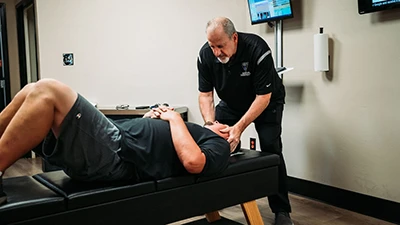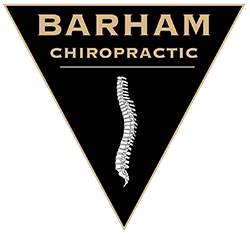Science Proves Chiropractic Neck Adjustments in Sacramento CA Are Extremely Safe (19 Reliable Studies Cited)

Are neck adjustments really safe?
Yes. The studies unequivocally show neck adjustments are unlikely to cause injury.
Some people think chiropractic neck adjustments are unsafe, however, neck adjustments are very safe when performed properly.
Chiropractic neck adjustments in Sacramento CA are a manual manipulation of the cervical spine, which is typically administered while the patient is sitting or lying on a padded chiropractic drop table.
Chiropractic neck adjustments are performed by practitioners all over the world due to their fast results and low risk. A mayo clinic study says that ”Chiropractic adjustment is safe when it's performed by someone trained and licensed to deliver chiropractic care.” Often, our patients experience immediate and long-term relief from neck adjustments.
The reason we wrote this article is that we hear and empathize with how some new patients feel.
It can be scary to have any treatment that directly involves neck manipulation.
If you are experiencing headaches or other issues caused by a misalignment of the neck we would love to share information about neck adjustments so that you can do what is right for you.
What are Chiropractic Neck Adjustments?
Neck adjustments are having the vertebrae within the upper back and neck manually realigned (or adjusted) so that they rest in the normal healthy position they belong in. The technique most commonly used in this treatment is known as manual manipulation. It involves realignment of the spine by hand to solve vertebral subluxations.
Types of Chiropractic Neck Adjustments in Sacramento CA
Different chiropractors use different techniques but the four most common types of chiropractic neck adjustments are:
Cervical Mobilization
This technique focuses on utilizing light pressure around the base neck to guide the spine back into alignment while the patient turns their head. It involves gently moving the head from side to side while the doctor gently pushes on areas that are out of alignment so that they can be gently guided back to where they belong.
This adjustment is a bit slower but it is by far the most gentle of the three and is perfect for people who may not be ready to do the other adjustments.
Cervical Drop
Cervical Drop is another useful technique that requires the patient to lie on a drop table on their stomach or side as the therapist moves the neck. To avoid excessive pressure, the patient usually lies on a headset as the drop table is shifted to adjust the neck. Once the therapist has positioned the neck for adjustment, they will release the drop table, and rotate the neck into the position it belongs in.
Cervical Manual Traction
This technique focuses on utilizing slight motions around the neck. It involves a high-velocity, low-amplitude technique that utilizes sudden pressure to realign an area. These adjustments are excellent for enhancing the range of motion without needing several adjustments or hours of stretches.
According to the national center of biotechnology information (Abi-Aad & Derian, 2022), this technique leads to noticeable symptomatic relief.
Soft Tissue Work
For this technique, a chiropractor or a masseuse will softly massage the neck and apply pressure to the swollen area. As a result, the neck will increase blood flow and relax the muscles in the area.
How do Chiropractic Neck Adjustments help?
There are three major benefits of receiving chiropractic neck adjustments.
- Relieve chronic pain and stiffness of the neck (Holz, 2019).
- It offers pain relief without medicines and surgery (Hawk et al., 2020).
- Relieves migraines, headaches, and circulatory problems (Pu Chu & Chieh Lin, 2022).
Risks Associated with Chiropractic Neck Adjustments
According to NCBI (Ernst, 2007), chiropractic neck adjustment has some very rare but note-worthy risks.
A good chiropractor should assess whether or not you are a good fit to receive neck adjustments, at Barham Chiropractic, we make sure that patients are able to receive adjustments safely by taking x-rays and performing several assessments during your first visit.
Stroke: The sudden movement of joints in the neck during a spinal adjustment can cause a minor or significant tear in the artery's wall (Ernst, 2020). It is a rare complication, but you need to keep it in mind.
Hypermobility and perpetual instability: When your neck starts moving excessively, this can potentially crack your neck. If you practice chiropractic neck adjustments too often, the ligaments will likely stretch permanently (Hawkins, n.d.), leading to perpetual instability.
These complications are very rare, and they become even less likely to occur when chiropractors take the time to properly assess whether or not the patient is ready to receive care. Unfortunately, they are the reason why many people are apprehensive before receiving their first neck adjustment. We have never had someone experience these complications at our office after care.
Check out our short testimonials page we have several videos of patients resolving neck issues. (Some of the videos are older, bear with us we recently started focusing on recording more testimonials again)
Do I need to be in pain to Get a Chiropractic neck Adjustment?
No. You do not need to be in pain to receive any chiropractic adjustments. Frankly, receiving care before you are in pain can PREVENT injuries and diseases caused by misalignments.
As a matter of fact, a lot of people, like our friend Eric here (on video), have a very high pain tolerance and do not even experience neck pain. Eric was able to have amazing progress in increasing neck mobility AND reducing neck pain.
How long does it take a chiropractor to fix neck issues?
Depending on the extent of your spinal injury, you may feel a reduction in pain of 40-80% following your first visit. Normally our patients experience general improvement within 1 to 4 weeks from the start of chiropractic therapy.
Are neck adjustments right for me?

The best way to figure that out is by having a doctor get x-rays and conduct range of motion tests and other assessments. At Barham Chiropractic we make to assess patients carefully and that they understand the treatment they are receiving.
If you are still concerned about neck adjustments, stop by our office or give us a call during office hours at (916) 542-6273.
References
Abi-Aad, K. R., & Derian, A. (2022). Cervical Traction. Textbook on Neurological and Neurosurgical Nursing, 663–663. https://doi.org/10.5005/jp/books/12672_158
Chaibi, A., & Russell, M. B. (2019). A risk–benefit assessment strategy to exclude cervical artery dissection in spinal manual-therapy: a comprehensive review. Https://Doi.Org/10.1080/07853890.2019.1590627, 51(2), 118–127. https://doi.org/10.1080/07853890.2019.1590627
Chu, E. C. P., & Ng, M. (2018). Long-term relief from tension-type headache and major depression following chiropractic treatment. Journal of Family Medicine and Primary Care, 7(3), 629. https://doi.org/10.4103/JFMPC.JFMPC_68_18
Derbyshire, S., Field, J., Vennik, J., Sanders, M., & Newell, D. (2021). “Chiropractic is manual therapy, not talk therapy”: a qualitative analysis exploring perceived barriers to remote consultations by chiropractors. Chiropractic and Manual Therapies, 29(1), 1–8. https://doi.org/10.1186/S12998-021-00404-2/FIGURES/1
Ernst, E. (2007). Adverse effects of spinal manipulation: a systematic review. Journal of the Royal Society of Medicine, 100(7), 330. https://doi.org/10.1258/JRSM.100.7.330
Ernst, E. (2020). Direct Risks of Spinal Manipulation. Chiropractic, 137–158. https://doi.org/10.1007/978-3-030-53118-8_14
Hawk, C., Whalen, W., Farabaugh, R. J., Daniels, C. J., Minkalis, A. L., Taylor, D. N., Anderson, D., Anderson, K., Crivelli, L. S., Cark, M., Barlow, E., Paris, D., Sarnat, R., & Weeks, J. (2020). Best practices for chiropractic management of patients with chronic musculoskeletal pain: A clinical practice guideline. Journal of Alternative and Complementary Medicine, 26(10), 884–901. https://doi.org/10.1089/ACM.2020.0181/ASSET/IMAGES/LARGE/ACM.2020.0181_FIGURE2.JPEG
Hawkins, D. L. (n.d.). EQUINE CHIROPRACTIC OVERVIEW.
Herman, P. M., Edgington, S. E., Hurwitz, E. L., & Coulter, I. D. (2020). Predictors of visit frequency for patients using ongoing chiropractic care for chronic low back and chronic neck pain; Analysis of observational data. BMC Musculoskeletal Disorders, 21(1), 1–14. https://doi.org/10.1186/S12891-020-03330-1/TABLES/3
Hjertstrand, J., Palmgren, P. J., Axén, I., & Eklund, A. (2021). The nordic maintenance care program: patient experience of maintenance care—a qualitative study. Chiropractic and Manual Therapies, 29(1), 1–14. https://doi.org/10.1186/S12998-021-00388-Z/FIGURES/1
Holz, K. (2019). Chiropractic Manipulation and Shockwave Therapy versus Chiropractic Manipulation and Myofascial Dry Needling on Mechanical Low Back Pain with Associated Active Quadratus Lumborum Trigger Points.
Kendall, J. C., French, S. D., Hartvigsen, J., & Azari, M. F. (2018). Chiropractic treatment including instrument-assisted manipulation for non-specific dizziness and neck pain in community-dwelling older people: A feasibility randomised sham-controlled trial. Chiropractic and Manual Therapies, 26(1), 1–11. https://doi.org/10.1186/S12998-018-0183-1/TABLES/3
Marthick-Hone, D., Doyle, A. K., Kennedy, G. A., Vindigni, D., & Polus, B. I. (2022). The importance of setting and therapeutic relationships when delivering chiropractic care to those living with disadvantage. Chiropractic and Manual Therapies, 30(1), 1–14. https://doi.org/10.1186/S12998-022-00456-Y/TABLES/3
Mortenson, M., Montgomery, A., & Buttermann, G. (2022). Chiropractic Care of a Female Veteran After Cervical Total Disk Replacement: A Case Report. Journal of Chiropractic Medicine, 21(1), 60–65. https://doi.org/10.1016/J.JCM.2022.02.008
Nim, C. G., Lauridsen, H. H., O’Neill, S., Goncalves, G., Jensen, R. K., & Leboeuf-Yde, C. (2020). Chiropractic conservatism among chiropractic students in Denmark: prevalence and consequences. Chiropractic and Manual Therapies, 28(1), 1–18. https://doi.org/10.1186/S12998-020-00352-3/FIGURES/1
Pu Chu, E., & Chieh Lin, A. (2022). Relief of postural orthostatic tachycardia syndrome with chiropractic rehabilitation. Journal of Family Medicine and Primary Care, 11(7), 4006. https://doi.org/10.4103/JFMPC.JFMPC_2108_21
Siccardi, D., Buzzatti, L., Marini, M., & Cattrysse, E. (2020). Analysis of three-dimensional facet joint displacement during two passive upper cervical mobilizations. Musculoskeletal Science and Practice, 50, 102218. https://doi.org/10.1016/J.MSKSP.2020.102218
Tulimero, J. M., James Mckivigan, G., & Tulimero, G. (2020). An Analysis of Graston Technique® for Soft-Tissue Therapy. Rehabilitation Science, 5(4), 31. https://doi.org/10.11648/j.rs.20200504.11
Wang, P., Zuo, G., Du, S. Q., Gao, T. C., Liu, R. J., Hou, X. Z., Ji, X., Yin, J., Li, K. M., & Zhang, Q. (2020). Meta-analysis of the therapeutic effect of acupuncture and chiropractic on cervical spondylosis radiculopathy: A systematic review and meta-analysis protocol. Medicine, 99(5), e18851. https://doi.org/10.1097/MD.9165426273018851
Clinically reviewed by Steven Barham, D.C.
- Updated on November 25, 2022
This site is for informational and educational purposes only. The information contained herein does not constitute the rendering of insurance advice, chiropractic healthcare advice, or the provision of treatment or treatment recommendations by our providers. Browsing this site does not establish a professional relationship with Barham Chiropractic or any member of the Barham Chiropractic staff.
If you have any concerns, questions, or comments about this article please reach out to our content moderation team at:
barhamcontent@gmail.com
You can also reach out to our Sacramento CA Chiropractor Office via phone call at (916) 542-6273 during office hours.
OFFICE HOURS
Monday
7:15am - 11:45am
2:00pm - 5:45pm
Tuesday
8:00am - 11:45am
Wednesday
7:15am - 11:45am
2:00pm - 5:45pm
Thursday
8:00am - 10:45am
Friday
7:15am - 11:45am
2:00pm - 5:45pm
Saturday & Sunday
Closed
Barham Chiropractic
3441 Arden Wy
Sacramento, CA 95825




